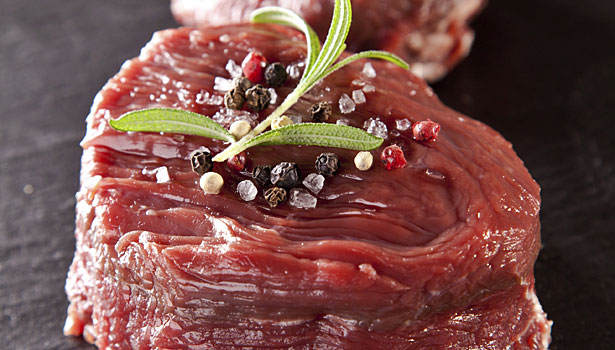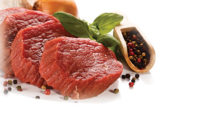Special Report
Portion implosion
Even without a definition for standard portion sizes, consumers continue to shrink their helpings of meat and poultry in the face of healthy-eating desires.

Cutting down on portion sizes is second only to choosing leaner cuts of meat in healthy eating strategies consumers use regarding eating meat and poultry, finds the “2014 Power of Meat” report from the American Meat Institute and Food Marketing Institute. A third of consumers “regularly” cut down on portion sizes while another 54 percent of those surveyed reported they “occasionally” do. In addition, 32 percent said they “regularly” limit second helpings of meat and poultry as a healthy-eating tactic with 53 percent of those sampled saying they “occasionally” do.
Healthy-eating practices in the meat department are driven by higher-income shoppers, the report finds. Consumers, who are very conscious about making healthier choices in the meat department, often are college-educated with above-average incomes, spend more than average on groceries, shop more often and likely purchase natural and/or organic meat and poultry, it shows. In addition, women most frequently focus on portion control by cutting down portion sizes and second helpings, the report says.
In addition, shoppers are turning to manufacturers for standardized portion size signals, according to a December 2013 Euromonitor International article, “Consumers Depend on Manufacturers for Reliable Portion Size Indicators.” In turn, public health organizations and academics are asking the industry to develop standardized portions to aid consumers.
“Again and again, research shows us that human beings are ill-equipped to judge what constitutes an adequate portion size, and also that they have trouble keeping track of how much they have already consumed in the absence of external visual cues,” wrote Simone Baroke, a contributing analyst for Euromonitor International in the article. “If leaving it all up to the consumer worked so well, we would not currently be looking in horror at spiraling obesity statistics across the globe.”
Matter of convenience
Portion control is an interesting concept for the fresh meat case.
“We’ve been talking about portion control for a long time, and there has never really been a time in the industry that I’ve known where portion control seems more relevant for our products in response to consumer needs,” says Michael Uetz, principal at Midan Marketing, in Chicago.
Uetz explains that the two biggest population groups, millennials and boomers, are looking for smaller sizes and single packages.
“They are not asking for the kind of sizes that we used to commonly get in the meat case,” Uetz says. “If we are going to continue to maintain their interest, we need to understand their demographic needs, the size of their households and start making some offerings that specifically address smaller pack size and portion control rather than just putting out in the case what we traditionally put out.”
Packaging remains an important feature for shoppers surveyed in the “2014 Power of Meat” report. Their comments for improving the meat department included many on portion size variety, and more convenient and less messy packaging. Shoppers also particularly appreciate resealable packaging options and innovations that reduce food waste and are freezer ready, which all correlate to portion control. For example, the warehouse club format attracts customers looking to purchase quality meat at bulk prices, but they would be able to increase their sales by offering more package size variety and pre-portioned bulk packages, the report finds.
Uetz agrees some of the more innovative products developed for the fresh-meat department during the past couple of years includes perforated, vacuum packed chicken and pork products. Convenience is the ultimate need of the consumer, he says.
“You can actually just tear off the product that you need and then put the rest in the freezer,” Uetz explains. “We as a meat department need to see more applications like that from a packaging perspective.”
Much of the portion control innovation is currently being driven from the manufacturing side, he says. Uetz believes the meat department needs to continue to see innovation from the packer/processor level in looking at packaging and how they can make product serving sizes more palatable for consumers relative to what they actually want to eat, can afford or want to spend on meat products.
Retailers also need to take a look at their product cases and consider if they are reaching millennials and boomers, Uetz says.
“If you go into many of the retailers in this country and check out their full-service case, there is a huge opportunity for them to really try to address what consumers are looking for,” he explains. “How do I add that convenience, how do I add that pre-seasoning or that pre-marination or offer to cut as much as you want and only provide to you exactly what you want to take home and try to hit a different price point? We’ve got people in the back of the full-service case whose goal it is to engage the customer and try to satisfy their needs. That’s the huge opportunity for us right now.”
Uetz believes the challenge becomes moving the abilities of the full-service case into the self-service case and taking some of these larger cuts and cutting them into smaller portions. In addition, larger carcasses for all proteins currently are coming through the system.
“Our opportunity to be consumer responsive is to make sure we don’t put out everything in large form, but, in fact, give a variety to the customer to be able to choose from that will ultimately result in a variety of price points based on what your family can afford.”
Price continues to be a driving force with consumers looking for value in most areas. One opportunity to show value in the meat case is displaying the nutritional value of the products, Uetz says. The halo effect of the nutritional information provided could evolve into consumers feeling better about buying meat and poultry products from the fresh case, he says.
In addition, the normally higher cost of portion control products could actually play in favor for the industry. “On a cost-per-pound basis, I believe consumers would be willing to pay a little extra because the total unit cost would be down,” Uetz says.
Looking for a reprint of this article?
From high-res PDFs to custom plaques, order your copy today!






